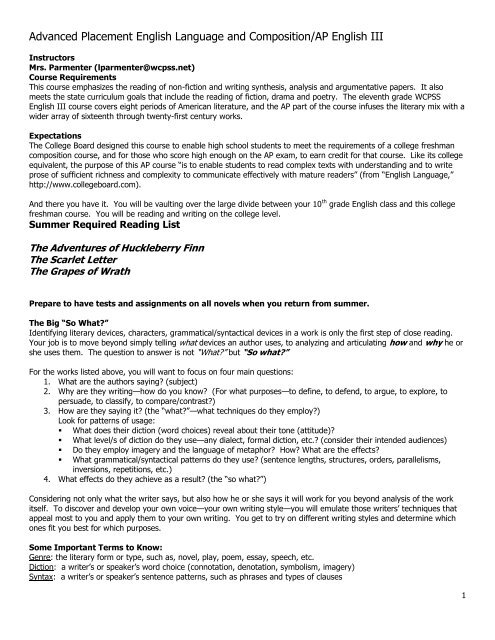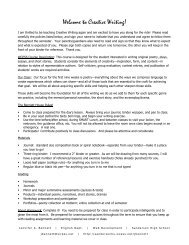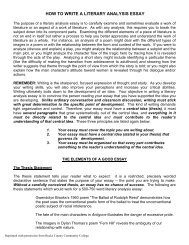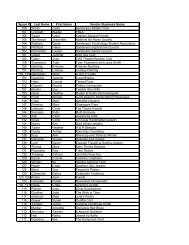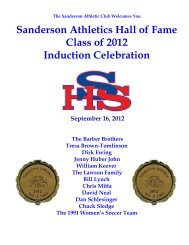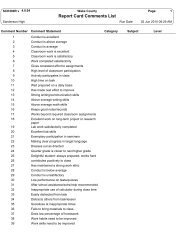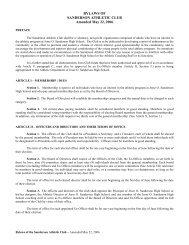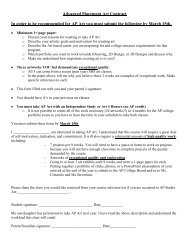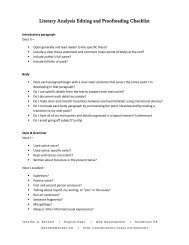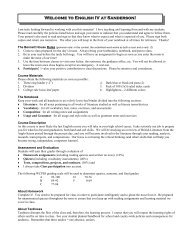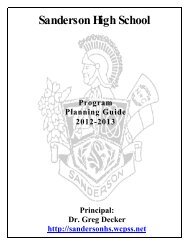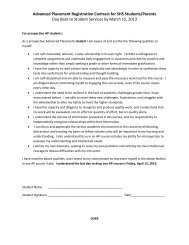Advanced Placement English Language and Composition/AP ...
Advanced Placement English Language and Composition/AP ...
Advanced Placement English Language and Composition/AP ...
You also want an ePaper? Increase the reach of your titles
YUMPU automatically turns print PDFs into web optimized ePapers that Google loves.
<strong>Advanced</strong> <strong>Placement</strong> <strong>English</strong> <strong>Language</strong> <strong>and</strong> <strong>Composition</strong>/<strong>AP</strong> <strong>English</strong> IIIInstructorsMrs. Parmenter (lparmenter@wcpss.net)Course RequirementsThis course emphasizes the reading of non-fiction <strong>and</strong> writing synthesis, analysis <strong>and</strong> argumentative papers. It alsomeets the state curriculum goals that include the reading of fiction, drama <strong>and</strong> poetry. The eleventh grade WCPSS<strong>English</strong> III course covers eight periods of American literature, <strong>and</strong> the <strong>AP</strong> part of the course infuses the literary mix with awider array of sixteenth through twenty-first century works.ExpectationsThe College Board designed this course to enable high school students to meet the requirements of a college freshmancomposition course, <strong>and</strong> for those who score high enough on the <strong>AP</strong> exam, to earn credit for that course. Like its collegeequivalent, the purpose of this <strong>AP</strong> course “is to enable students to read complex texts with underst<strong>and</strong>ing <strong>and</strong> to writeprose of sufficient richness <strong>and</strong> complexity to communicate effectively with mature readers” (from “<strong>English</strong> <strong>Language</strong>,”http://www.collegeboard.com).And there you have it. You will be vaulting over the large divide between your 10 th grade <strong>English</strong> class <strong>and</strong> this collegefreshman course. You will be reading <strong>and</strong> writing on the college level.Summer Required Reading ListThe Adventures of Huckleberry FinnThe Scarlet LetterThe Grapes of WrathPrepare to have tests <strong>and</strong> assignments on all novels when you return from summer.The Big “So What?”Identifying literary devices, characters, grammatical/syntactical devices in a work is only the first step of close reading.Your job is to move beyond simply telling what devices an author uses, to analyzing <strong>and</strong> articulating how <strong>and</strong> why he orshe uses them. The question to answer is not “What?” but “So what?”For the works listed above, you will want to focus on four main questions:1. What are the authors saying? (subject)2. Why are they writing—how do you know? (For what purposes—to define, to defend, to argue, to explore, topersuade, to classify, to compare/contrast?)3. How are they saying it? (the “what?”—what techniques do they employ?)Look for patterns of usage:• What does their diction (word choices) reveal about their tone (attitude)?• What level/s of diction do they use—any dialect, formal diction, etc.? (consider their intended audiences)• Do they employ imagery <strong>and</strong> the language of metaphor? How? What are the effects?• What grammatical/syntactical patterns do they use? (sentence lengths, structures, orders, parallelisms,inversions, repetitions, etc.)4. What effects do they achieve as a result? (the “so what?”)Considering not only what the writer says, but also how he or she says it will work for you beyond analysis of the workitself. To discover <strong>and</strong> develop your own voice—your own writing style—you will emulate those writers’ techniques thatappeal most to you <strong>and</strong> apply them to your own writing. You get to try on different writing styles <strong>and</strong> determine whichones fit you best for which purposes.Some Important Terms to Know:Genre: the literary form or type, such as, novel, play, poem, essay, speech, etc.Diction: a writer’s or speaker’s word choice (connotation, denotation, symbolism, imagery)Syntax: a writer’s or speaker’s sentence patterns, such as phrases <strong>and</strong> types of clauses1
Synthesis: the combining of separate elements or substances to form a coherent whole. In research synthesis refers tocritically selecting information from a variety of sources to inform your own discussion of a topic; combining sources <strong>and</strong> yourposition to form a cohesive, supported argument, documenting sources accurately.Modes of writing/ Rhetorical modes: the strategy a writer uses to accomplish his or her purposes (analysis, description,argument, contrast <strong>and</strong> comparison, cause <strong>and</strong> effect, narration <strong>and</strong> definition.)Note-taking SuggestionsHere is where your reading for analysis greatly enhances your reading for enjoyment, so take the types of notes that willbest help you to identify, analyze, <strong>and</strong>, ultimately, emulate the styles of great writers. Interact with the texts—talk tothem, ask questions, make observations <strong>and</strong> comments. The following are some note-taking suggestions:1. Dialectic journal/two-column notes: divide a loose-leaf page in half; write a thought-provoking line or phrase onleft side <strong>and</strong> write a personal response to it on the right side.2. Annotation: highlight, underline <strong>and</strong> write comments <strong>and</strong> questions in the margins. (can also be done with postits)3. Summary: Read a chapter of the novel. Close the book. Summarize what you have read. List major elements.Identify conflicts <strong>and</strong> turning points. Identify changes in style.4. SO<strong>AP</strong>Stone analysis: especially helpful for non-fiction works, you may want to use the attached SO<strong>AP</strong>Stone Toolfor Analysis as a guide.Whatever methods you choose for taking notes, look for the writer’s purpose <strong>and</strong> the best literary techniques <strong>and</strong>strategies the writer employs. See important terms to know (above).Bring all notes with you on the first day of class for your own reference. You will keep them in your course notebook.Assessments (be prepared for assessments beginning the first day of class)• Objective test on the allusions material (see attached study guide)• Essays <strong>and</strong> short answer identification(given in class): <strong>AP</strong> writing prompts requiring synthesis of several works todefend, refute, or qualify given arguments as well as identification <strong>and</strong> analysis of rhetorical modes <strong>and</strong> strategies.You may also be asked to identify the significance of items, characters, or quotes.Bring all notes with you on the first day of class for your own reference. You will keep them in your course notebook.Attachments• Allusions study guide (know where the allusions come from <strong>and</strong> what they are referencing); Grammar study guide(review this material over the summer); SO<strong>AP</strong>Stone analysis tool (use this to help with your reading of the novels.)Identifying <strong>and</strong> Analyzing AllusionsAn allusion is a brief reference within a work of literature/art to some well-known literary or historical character, place, idea,or event. This literary device enables writers to pack a world of meaning into a few words, connecting a concept in the work ofliterature with the meaning behind the allusion.The Bedford St. Martin’s Glossary of Literary Terms further elucidates this concept:Allusions conjure up biblical authority, scenes from Shakespeare’s plays, historic figures, wars, great love stories, <strong>and</strong> anythingelse that might enrich an author’s work. Allusions imply reading <strong>and</strong> cultural experiences shared by the writer <strong>and</strong> reader,functioning as a kind of shorth<strong>and</strong> whereby the recalling of something outside the work supplies an emotional or intellectualcontext, such as a poem about current racial struggles calling up the memory of Abraham Lincoln.The two most popular sources from which Western writers draw allusions are the Judeo-Christian Bible <strong>and</strong> the ancientclassical writings. From Beowulf to Bob Marley <strong>and</strong> beyond, western writers of all genres have alluded to characters, plots,places, <strong>and</strong> themes from the Bible <strong>and</strong> ancient Greek <strong>and</strong> Roman mythology. These allusions often carry significant meaningfor the work as a whole in which they appear; therefore, a foundational knowledge of the Bible <strong>and</strong> mythology greatlyenhances a reader’s underst<strong>and</strong>ing <strong>and</strong> appreciation of the poem, novel, play, movie, visual artwork, video game, cartoon,song, etc. that contains the allusions.Study to know the stories behind the following references; you will see many of them in this year’s literature alone. Yourknowledge of the back story—the context behind the allusion—will greatly enhance your underst<strong>and</strong>ing of the work thatreferences it. Be prepared for an objective assessment that tests your knowledge of the following allusions from a variety ofsources:1. Are we disposed to be the number of those who having eyes see not, <strong>and</strong> having ears hear not?2. We are apt to shut our eyes <strong>and</strong> listen to the song of that siren that transforms us into beasts.3. That’s the secret of Castle Rackrent.2
4. His career as Trimalchio was over.5. The professor's antedeluvian beliefs made him ill-suited for classroom teaching.6. Small bookstores can't compete against national chain goliaths.7. If not for the good Samaritan who jump-started her car, she might still be stuck on the side of the Interstate.8. The Job's comforters told him it was just as well he wasn't invited to the party; he didn't make nearly enough money tointerest any of the women there.9. I'm not going to carpool with that Jonah. Every vehicle she gets into ends up in an accident.10. I'm not going to leave that Judas alone with my boss while we're competing for the same promotion.11. He killed the fatted calf for the lavish anniversary party.12. The endorsement by a prominent neo-Nazi was the kiss of death to her senatorial campaign.13. Dealing with the crotchety old man every day for five years required the patience of Job.14. After ab<strong>and</strong>oning football for a semester of drunken frat parties, Northwestern's prodigal son Rick Hammond came backto lead the team to victory in the playoffs.15. Jim got a generous package of stock options for helping depose his partner as CEO, but the thirty pieces of silver didn't keephis conscience from gnawing at him.16. He was a shrewd business man <strong>and</strong> investor, but his Achilles heel was gambling.17. Why so Argus-eyed, my love?” cried Bill. “I swear I've been at the office this whole time!”18. What started out as a genteel <strong>and</strong> subdued dinner party degenerated into Bacchanalian ab<strong>and</strong>on as the hours wore on.19. Diane knew Sam had asked her not to get involved in his personal life, but she couldn't resist the urge to play Cupid <strong>and</strong> sethim up with Rebecca.20. The president believed he could cut through the Gordian knot of growing civil unrest by sending in the national guard withtear gas.21. With a Herculean effort, Valjean lifted the cart off the man trapped underneath.22. The investigation of drug use among the athletes opened a P<strong>and</strong>ora's Box implicating half the league.23. Although religious authorities <strong>and</strong> moralists objected to the new procedure, the Promethean scientists would not bedenied.24. The senator's protean policies always mirrored the whims of his electorate.25. She met her Waterloo at the Iowa caucus.26. The CEO sold his employees down the river by cutting their benefits while raising his own salary.27. The sybaritic banquet included four kinds of caviar, foie gras, <strong>and</strong> a $5,000 bottle of wine with each course.28. Bill Gates is as rich as Croesus!29. In a Pyrrhic victory, he managed to grab the last muffin, but he lost the goodwill of his friends.30. The city has its highest unemployment rate in decades, while the mayor attends upscale parties; she's fiddling while Romeburns.31. The activists sought to change the Draconian jaywalking laws.32. Nobody was sure how the donnybrook started, but it l<strong>and</strong>ed three partygoers in the hospital.33. I know he's a Casanova, but I can't resist those eyes.34. A bowdlerized version of Sex <strong>and</strong> the City was created for syndication on broadcast TV.35. The club decided to boycott any cosmetics company that tested products on animals.36. Everything was going well until that Benedict Arnold, Diane, gave our trade secrets to the competition.37. Some felt that the Svengali behind the reality TV show locked the winner into an unfairly restrictive contract.38. “She's such a Pollyanna,” grumbled Mary Anne, “she thinks the IRS auditor is calling to make sure they don't owe her anymoney.”39. Let him fix his own cocoa; you don't need to indulge his Peter Pan syndrome by mothering him.40. His neighbor borrowed all his tools months ago, but that milquetoast is too timid to ask for them back.41. The tabloids called Amy Fisher the “Long Isl<strong>and</strong> Lolita.”42. In one story, Sherlock Holmes refers to Watson as his Boswell.43. The linoleum mat would lift off the floor off the floor like the floating isl<strong>and</strong> of Gulliver or the carpet in the Arabian nights.44. It contained quotes from Emerson <strong>and</strong> Macauley <strong>and</strong> Benjamin Franklin <strong>and</strong> Shakespeare.45. It was as blank as a Gobi on a moonless night.46. It was a mixture of Svengali <strong>and</strong> an atom-busting machine.3
47. It was a plaster-of-Paris of Medusa.48. Even as Venus once shrouded Aeneas in a cloud, he passed unspied by men.49. A great man had fallen in Israel.50. The raven was perched upon a bust of Pallas just above my chamber door.51. Pythagoras was misunderstood, <strong>and</strong> Socrates, <strong>and</strong> Jesus, <strong>and</strong> Luther, <strong>and</strong> Copernicus, <strong>and</strong> Galileo <strong>and</strong> Newton.52. Pearl as being of great price—purchased with all she had—her mother’s only treasure.53. You can’t welcome a man <strong>and</strong> his wife without you making a comparison about Isaac <strong>and</strong> Rebecca at the well.54. The lonesomeness in the sparks made them hunt for one another, but the mud was deaf <strong>and</strong> dumb.Be prepared, also, to explain the significance behind allusions to the more popular biblical <strong>and</strong> mythological references below:• The Creation story• John the Baptist• The Garden of Eden• Herod, Herodias, <strong>and</strong> Salome (“head on a silver• The Fall of Manplatter”)• Cain & Abel (“Am I my brother’s keeper?”)• The disciples (Simon Peter, John, Thomas, <strong>and</strong>• Noah & the FloodJudas Iscariot—most alluded to)• The Tower of Babel• The Miracles—esp.• Abraham & Isaaco The Wedding at Cana,• Jacob & Esauo Walking on Water,• Sodom & Gomorrah /pillar of salto Calming the Sea,• The Tribes of Israelo The Loaves <strong>and</strong> Fishes,• Joseph <strong>and</strong> his coat of many colorso Raising Lazarus• Moses <strong>and</strong> the Exodus• The Sermon on the Mount (The Beatitudes)• The Burning Bush• The Parables—esp.• The Plagues of Egypto The Lost Sheepo The Lost (Prodigal) Son <strong>and</strong>• The Passover <strong>and</strong> the Red Sea Passageo The Good Samaritan• The Ten Comm<strong>and</strong>ments• The Pharisees• The Promised L<strong>and</strong>• The Last Supper (symbolism of bread <strong>and</strong> wine)• Philistines• Betrayal <strong>and</strong> Denial• Samson & Delilah• Pontius Pilate <strong>and</strong> symbolism of h<strong>and</strong> washing• Saul• The Crucifixion, Resurrection, <strong>and</strong> Ascension• David & Goliath• Doubting Thomas• David & Bathsheba• Saul/Paul• Absalom’s rebellion• The Road to Damascus• Solomon <strong>and</strong> the temple• From the book of Revelation• Passing down a mantle of leadershipo Four Horsemen of the Apocalypse• Ahab <strong>and</strong> Jezebelo the Anti-Christ• Isaiah the Propheto the Beast (number)• Daniel in the Lion’s Deno the Lake of Fire• Nebuchadnezzar <strong>and</strong> the Fiery Furnaceo the Whore of Babylon• The h<strong>and</strong>writing on the wallo the New Jerusalem• Jonah <strong>and</strong> the Whale• The Nativity of JesusFrom Mythology4
the major gods/goddesses of Olympus• the Titans• the Underworld• Cerberus• Demeter <strong>and</strong> Persephone• Rivers Styx <strong>and</strong> Lethe• Elysian Fields• Dionysus/Bacchus• Poseidon• Muses• Furies• Sirens• Fates• Prometheus• P<strong>and</strong>ora (<strong>and</strong> her box)• Narcissus• Adonis• Hercules• Pygmalion• Icarus & Daedalus• Paris & Helen of Troy• Trojan Horse• Odysseuso the Sirenso the Lotuso “between a rock <strong>and</strong> a hard placeYou need to know basic facts about the above references to be able to recognize the significance of any allusions tothem.VERY IMPORTANT NOTE: For those of you who have attended church or Sunday School, please do not assume that youknow all of the biblical references. Every year students fall into that trap <strong>and</strong> fail the test. The same concept applies tothose who studied some mythology in the 9 th or 10 th grades.Review this Grammar. You will be identifying grammar usage as we work through essays during the year.Basic Parts of SpeechBe able to define, identify, <strong>and</strong> create examples for each of the following terms below:NounsCommon & properConcrete & abstractCompoundCollectivePronounsPersonal (number, gender, case: nominative, objective, possessive)DemonstrativeReflexive5
IntensiveRelativeInterrogativeIndefinite (which are singular, which are plural, which could be either, depending on context?)VerbsActionLinkingAuxiliariesTransitive (objects) & intransitiveVerb phrasesAdjectives• What classes of words do they modify?• What questions do they answer about the words they modify?• What other classes of words can be adjectives? How do you determine part of speech?• Demonstrative• Proper• Articles (definite & indefinite)Adverbs• What classes of words do they modify?• What questions do they answer about the words they modify?• What other classes of words can be adverbs? How do you determine part of speech?Prepositions• What are they?• What question/s should you ask to determine whether or not a word/phrase functions as a preposition?• Compound prepositions• Prepositional phrases• Objects of prepositionsConjunctions• Coordinating• Subordinating• CorrelativeInterjectionsVerbals• Participle• Gerund• InfinitiveThe Parts of a Sentence (Ch. 15)Be able to define, identify, <strong>and</strong> create examples for each of the following terms below:• Sentence• FragmentSubject• Simple• Complete• CompoundPredicate• Simple• Complete6
• Compound verbComplements• Direct object• Indirect object• Objective complement• Subject complemento Predicate nominativeo Predicate adjectiveSentence Classification• Imperative• Declarative• Interrogative• ExclamatoryPhrases (Ch. 16)Prepositional• Adjective phrase• Adverb phraseVerbal• Participial• Gerund• InfinitiveAppositiveClauses (Ch. 17)Independent/mainDependent/subordinate• Adjective (+ relative pronouns)o Essential/restrictive <strong>and</strong> Nonessential/nonrestrictive• Noun• Adverb (+ subordinating conjunctions)• EllipticalSentence StructuresSimpleCompoundComplexCompound-complexSubject-Verb AgreementPronoun-Antecedent AgreementTools for Analysis: S.O.A.P.S.ToneSpeaker:Is there someone identified as the speaker?Can you make some assumptions about this person?o What social class does the author come from?o What political bias can be inferred?o What gender is the speaker?P.S. Be sure to underst<strong>and</strong> the difference, if any, between author <strong>and</strong> speaker in the passage.Occasion:Immediate occasiono What may have prompted the author/speaker to write this piece?7
o What event led to its publication or development?Larger occasiono The bigger idea behind the piece; the broad issueo The center of ideas <strong>and</strong> emotions in the workAudience:Does the speaker identify an audience?What assumptions can you make about the audience? Is it mixed in terms of race, politics, gender, social class,religion, etc.?Does the speaker use language that is specific for a unique audience?Does the speaker evoke Nation? Liberty? God? History? Hell?Does the speaker allude to any particular time in history such as ancient times? Industrial Revolution? WorldWars? Vietnam?Purpose:What is the speaker’s purpose?In what ways does the author convey this message?How is the speaker trying to spark a reaction in the audience?How is this document supposed to make you feel?Subject:What is the subject of the piece? How do you know this?How has the author presented this subject?Tone:What seems to be the emotional state of the speaker?What is the speaker’s or author’s attitude toward the subject?What words or phrases reveal the speaker’s tone?How else does the writer reveal that attitude? (i.e. images, metaphorical language, sentence structure)8


